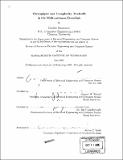| dc.contributor.advisor | Gregory W. Wornell and Elif Uysal-Biyikoglu. | en_US |
| dc.contributor.author | Swannack, Charles (Charles Henry) | en_US |
| dc.contributor.other | Massachusetts Institute of Technology. Dept. of Electrical Engineering and Computer Science. | en_US |
| dc.date.accessioned | 2006-09-28T15:05:35Z | |
| dc.date.available | 2006-09-28T15:05:35Z | |
| dc.date.copyright | 2005 | en_US |
| dc.date.issued | 2005 | en_US |
| dc.identifier.uri | http://hdl.handle.net/1721.1/34124 | |
| dc.description | Thesis (S.M.)--Massachusetts Institute of Technology, Dept. of Electrical Engineering and Computer Science, 2005. | en_US |
| dc.description | Includes bibliographical references (p. 75-77). | en_US |
| dc.description.abstract | This thesis considers the joint design of the multiplexing and scheduling of independent data streams for the Gaussian multiple-input multiple-output (MIMO) broadcast channel. It is well known that the use of multiple transmit antennas can greatly increase the capacity of the broadcast channel. However, the complexity of a capacity-achieving strategy is dominated by the underlying search for the best user subset to multiplex across the transmitter array, which can be prohibitively high if the number of users is much greater than the transmit dimension. To reduce this complexity, one can limit the search to a smaller set of users while ensuring that this restricted pool contains a set that is close to optimal with high probability. To this end, we define sets with guaranteed signal to interference ratio (SIR) and signal to noise ratio (SNR) values. We provide bounds on the probability that such a set exists. These bounds are derived through an interpretation of the multi-user multi-antenna channel as a random packing of the unit sphere. As such, we provide refined estimates on the content of spherical caps so that they can be applied as a model for interference. We then employ recent developments in the area of random geometric graph theory to characterize the probability of existence. | en_US |
| dc.description.abstract | (cont.) We further show there is a phase transition phenomenon in channel geometry that can be used in the design of efficient algorithms for scheduling in the MIMO broadcast channel. Further, we use this transition to provide novel lower bounds for the expected rate of any multiplexer in a channel with choice. | en_US |
| dc.description.statementofresponsibility | by Charles Swannack. | en_US |
| dc.format.extent | 77 p. | en_US |
| dc.format.extent | 3346386 bytes | |
| dc.format.extent | 3349522 bytes | |
| dc.format.mimetype | application/pdf | |
| dc.format.mimetype | application/pdf | |
| dc.language.iso | eng | en_US |
| dc.publisher | Massachusetts Institute of Technology | en_US |
| dc.rights | M.I.T. theses are protected by copyright. They may be viewed from this source for any purpose, but reproduction or distribution in any format is prohibited without written permission. See provided URL for inquiries about permission. | en_US |
| dc.rights.uri | http://dspace.mit.edu/handle/1721.1/7582 | |
| dc.subject | Electrical Engineering and Computer Science. | en_US |
| dc.title | Throughput and complexity tradeoffs in the multi-antenna downlink | en_US |
| dc.type | Thesis | en_US |
| dc.description.degree | S.M. | en_US |
| dc.contributor.department | Massachusetts Institute of Technology. Department of Electrical Engineering and Computer Science | |
| dc.identifier.oclc | 67766982 | en_US |
